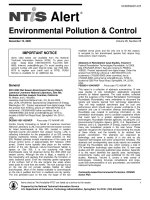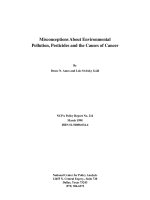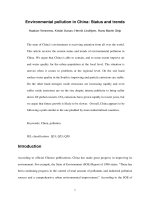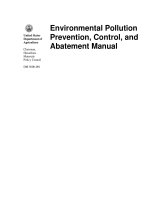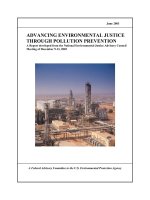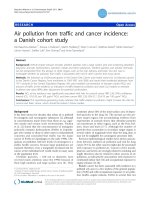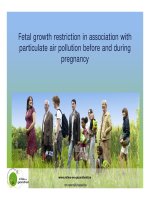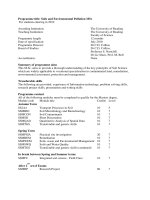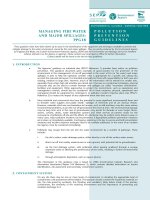Environmental Pollution Prevention, Control, and Abatement Manual potx
Bạn đang xem bản rút gọn của tài liệu. Xem và tải ngay bản đầy đủ của tài liệu tại đây (548.31 KB, 89 trang )
United States
Department of
Agriculture
Chairman,
Hazardous
Materials
Policy Council
DM 5600-001
Environmental Pollution
Prevention, Control, and
Abatement Manual
INTRODUCTION
The purpose of this manual is to serve as a directive for the prevention, control, and
abatement of environmental pollution from U.S. Department of Agriculture (USDA)
facilities, administered lands, and activities. The manual provides objectives, policy,
responsibilities, and technical standards and requirements under which the Department
plans to manage the various environmental programs to achieve compliance with
applicable pollution control standards.
The manual is divided into chapters with respect to the various media programs,
including air, water, drinking water, solid and hazardous waste, hazardous substances,
mixed hazardous and low-level radioactive waste, pesticides and toxic substances,
environmental management systems, and oil pollution. The manual also contains
chapters on overall Departmental policy, administration, planning, programming and
budgeting.
Each manual chapter is divided into sections describing the purpose, scope, objectives,
and agency responsibilities for the individual environmental programs under discussion.
Each chapter also describes the basic substantive and procedural standards and general
requirements and authorities that agencies must meet to achieve compliance when
applicable.
USERS OF THIS MANUAL ARE REMINDED THAT THERE IS NO ADEQUATE
SUBSTITUTE FOR THE ACTUAL STATUTES AND REGULATIONS. The manual
is meant to be used as an introduction to the extensive and complex statutory and
regulatory schemes. Agencies must keep appraised of the current statutes, regulations
and Executive Orders and refer to them to gain a full understanding of their obligations
and responsibilities. Furthermore, agencies must consult with the Office of the General
Counsel (OGC) when issues regarding these statutes and regulations arise.
The technical regulations and standards are very dynamic in nature. The U.S.
Environmental Protection Agency (EPA) periodically revises and updates environmental
regulations and guidance documents. Also, applicable environmental standards and
requirements established by individual States may be more stringent than the Federal
standards and requirements. Therefore, USDA agencies should contact appropriate
regulatory agencies in the earliest phase of individual project planning to determine the
requirements for any particular facility or activity.
TABLE OF CONTENTS
Introduction
Table of Contents
1
2
3
4
5
I
Purpose
Explanation of Changes
Filing Instruction
Maintenance of Manual
Agency Supplementation
1
1
1
1
2
Prevention, Control, and Abatement of Air, Water, and Other Pollution
Concerning Federal Facilities, Administered Lands, and Activities
1
2
3
4
5
6
7
8
II
i
Purpose
Scope
Authorities
Objectives
Policy
Definitions
Responsibilities
Compliance with Other Environmental Statutes
3
3
3
3
5
6
7
7
18
19
1
2
3
4
5
III
Environmental Compliance and Management Training
19
19
20
21
22
Purpose
Objective
Policy
Responsibilities
Requirements
Clean Water Program
24
1
2
3
4
5
24
24
24
24
24
Purpose
Scope
Authorities
Objectives
Policy
i
IV
27
1
2
3
4
5
6
7
V
Safe Drinking Water Program
27
27
27
27
27
30
30
Purpose
Scope
Authorities
Objective
Policy
Definitions
Responsibilities
31
1
2
3
4
VI
Comprehensive Environmental Response, Compensation, and Liability Act
Program
31
31
31
31
Purpose
Scope
Authorities
Policy
34
1
2
3
4
5
VII
Solid and Hazardous Waste Management Program
34
34
34
34
35
Purpose
Scope
Authorities
Objective
Policy
Pesticides and Toxic Substances Management Program
37
1
2
3
4
5
37
37
37
37
38
Purpose
Scope
Authorities
Objective
Policy
VIII Clean Air Program
1
2
3
4
5
6
40
Purpose
Scope
Authorities
Objectives
Policy
Responsibilities
40
40
40
40
40
42
ii
IX
44
1
2
3
4
5
6
7
X
Environmental Management Systems Program
44
44
44
45
45
46
47
Purpose
Scope
Authorities
Objectives
Policy
Definitions
Responsibilities
51
1
2
3
4
5
XI
Oil Pollution Program
51
51
51
51
51
Purpose
Scope
Authorities
Objectives
Policy
53
1
2
3
4
5
6
7
XII
Planning, Budget Preparation, Program Management, and Accomplishment
Reporting
53
53
53
53
55
55
59
Purpose
Scope
Objectives
Definitions and Acronyms
Responsibilities
Budget-Cycle Schedule of HMMP Planning and Reporting
Procedures
Emergency Oil Discharge and Hazardous Substances Release Response Program
63
1
2
3
4
5
6
7
63
63
63
63
64
65
66
Purpose
Scope
Objectives
Policy
Responsibilities
Reporting
Technical and Logistical Assistance
iii
XIII Low-level Radioactive/Mixed Waste Management
and Burial Site Cleanup Program
1
2
3
4
5
6
7
Purpose
Scope
Authorities
Objectives
Policy
Definitions
Responsibilities
67
67
67
68
68
68
68
XIV Environmental Compliance For Real Property Acquisition or Disposal
1
2
3
4
5
6
7
67
Purpose
Scope
Authorities
Objectives
Policy
Definitions
Responsibilities
70
70
70
70
70
71
72
73
Appendix A: Glossary of Terms
Appendix B: List of Acronyms
A-1
B-1
iv
U.S. DEPARTMENT OF AGRICULTURE
WASHINGTON, D.C. 20250
N u m b er:
DEPARTMENTAL MANUAL
5600-001
SUBJECT:
DATE:
Environmental Pollution Prevention, Control, and
Abatement Manual
November 18, 2004
OPI:
Chairman, Hazardous Materials
Policy Council
1
PURPOSE
This revision of Departmental Manual 5600-001 supersedes the previous DM 5600001 issued on December 9, 1992; as amended by DM 5600-001 Amendment 1 issued
on June 25, 1999 and Amendment 2 issued on December 1, 2000; adds a new Chapter
XIV and an Appendix B.
2
EXPLANATION OF CHANGES
This revision eliminates Chapter VIII - Environmental Noise Abatement Program and
moves Chapter II - Clean Air Program to replace Chapter VIII - Clean Air Program;
creates a new Chapter II - Environmental Compliance and Management Training;
replaces Chapter III - Clean Water Program, Chapter IV - Safe Drinking Water
Program, and Chapter VI - Solid and Hazardous Waste Management Program;
renames Chapter VII - Hazardous and Toxic Materials Management Program as
Chapter VII - Pesticides and Toxic Substances Management Program; replaces
Chapter IX - Pollution Prevention Act Program with a new Chapter IX Environmental Management Systems Program; adds a new Chapter XIV Environmental Compliance For Real Property Acquisition or Disposal; creates a new
Appendix B - List of Acronyms; and makes minor corrections to Chapters I, V, XI,
XII, XIII, and Appendix A.
3
FILING INSTRUCTIONS
Previous editions of DM 5600-001 are not usable. Replace in its entirety with this
document.
4 MAINTENANCE OF MANUAL
The Chairman of the Hazardous Materials Policy Council (HMPC) will be responsible
for the issuance of any amendments to this manual. The manual will be updated on a
continuing basis as necessary to achieve compliance with new or revised
requirements.
1
DM 5600-001
November 18, 2004
5 AGENCY SUPPLEMENTATION
Consistent with USDA policies, agencies may supplement this manual with agency
policy and direction as necessary. However, agency supplements may not be issued
on white or yellow paper. Copies of all agency supplements should be forwarded to
the Hazardous Materials Management Group (HMMG) for review and approval by
the HMPC.
2
November 18, 2004
DM 5600-001
PREVENTION, CONTROL, AND ABATEMENT OF AIR, WATER,
AND OTHER POLLUTION CONCERNING FEDERAL FACILITIES,
ADMINISTERED LANDS, AND ACTIVITIES
Chapter I
1
PURPOSE
This chapter prescribes USDA policies, responsibilities, and procedures for complying
with applicable environmental laws, regulations, Executive Orders, and the Government
Performance and Results Act (GPRA) in relation to protection, preservation, and
restoration of the environment including preventing pollution through waste
minimization, source reduction, and recycling.
2
SCOPE
The provisions of this chapter apply to all facilities, lands and activities under the
jurisdiction, custody, and control of USDA. To the extent provided by law, they apply to
contractors, cooperators, concessionaires, and others performing work for USDA,
including those responsible for management and operation of USDA facilities; to special
use and other permittees operating at facilities and on lands under the jurisdiction,
custody and control of USDA; and to activities performed by USDA assistance
recipients.
3
AUTHORITIES
The following authorities are the major statutes and Executive Orders relating to the
prevention, control, and abatement of pollution. This list is not intended to be exhaustive.
Other authorities may be applicable to a particular matter.
a
Clean Air Act (CAA), as amended, 42 USC 7401, et seq.
b
Comprehensive Environmental Response, Compensation, and Liability Act
(CERCLA) (also known as "Superfund"), as amended, 42 USC 9601, et seq.
c
Emergency Planning and Community Right-to-Know Act (EPCRA), 42 USC
11001, et seq.
d
Federal Insecticide, Fungicide, and Rodenticide Act (FIFRA), as amended, 7 USC
136, et seq.
e
Federal Water Pollution Control Act (FWPCA) (also known as “Clean Water Act
3
DM 5600-001
November 18, 2004
(CWA)”), as amended, 33 USC 1251, et seq.
f
Oil Pollution Act (OPA), as amended, 33 USC 2701, et seq.
g
Pollution Prevention Act (PPA), 42 USC 13101, et seq.
h
Resource Conservation and Recovery Act (RCRA), as amended, 42 USC 6901, et
seq.
i
Safe Drinking Water Act (SDWA), as amended, 42 USC 300f, et seq.
j
Toxic Substances Control Act (TSCA), as amended, 15 USC 2601, et seq.
l
Executive Order 11738, providing for Administration of the Clean Air Act and
the Federal Water Pollution Control Act with respect to Federal Contracts, Grants,
or Loans, September 10, 1973, 38 FR 25161 (September 12, 1973).
m
Executive Order 12088, Federal Compliance with Pollution Control Standards,
October 13, 1978, 43 FR 47707 (October 17, 1978).
n
Executive Order 12372, Intergovernmental Review of Federal Programs, July 14,
1982, 47 FR 30959, (July 16, 1982), as amended by Executive Order 12416, April
8, 1983, 48 FR 15587 (April 11, 1983).
o
Executive Order 12580, Superfund Implementation, January 23, 1987, 52 FR
2923 (January 29, 1987), as amended by Executive Order 13016 (CERCLA
Section 106 Order Authority), August 28, 1996, 61 FR 45871 (August 30, 1996),
as further amended by Executive Order 13308, June 20, 2003, 68 FR 37691 (June
24, 2003).
p
Executive Order 12777, Implementation of Section 311 of the Federal Water
Pollution Control Act of October 18, 1972, as Amended, and the Oil Pollution Act
of 1990, October 18, 1991, 56 FR 54757 (October 22, 1991).
q
Executive Order 12843, Procurement Requirements and Policies for Federal
Agencies for Ozone-depleting Substances, April 21, 1993, 58 FR 21881 (April
23, 1993).
r
Executive Order 12856, Federal Compliance with Right-to-Know Laws and
Pollution Prevention Requirements, August 3, 1993, 58 FR 41981 (August 6,
1993).
s
Executive Order 13101, Greening the Government Through Waste Prevention,
Recycling, and Federal Acquisition, September 14, 1998, 63 FR 49643
(September 16, 1998).
4
November 18, 2004
DM 5600-001
t
u
Office of Management and Budget (OMB) Circular A-11, Preparation and
Submission of Budget Estimates, June 1989.
v
4
Executive Order 12898, Federal Actions to Address Environmental Justice in
Minority Populations and Low-income Populations, February 11, 1994, 59 FR
7629 (February 16, 1994), as amended by Executive Order 12948, January 30,
1995, 60 FR 6381 (February 1, 1995).
Executive Order 13148: Greening the Government Through Environmental
Leadership, 65 FR 24595 (April 26, 2000).
OBJECTIVES
USDA is committed to planning, developing, and implementing all programs and
projects so as to minimize adverse impacts on the quality of the environment and to
restore impacted resources in concert with the Department's overall mission. To achieve
this goal, USDA and component agencies will:
a
Minimize the acquisition, storage, and use of hazardous, toxic, and extremely
hazardous substances, consistent with mission requirements.
b
Manage the use, storage, discharge or disposal of pollutants and hazardous and
toxic substances generated by agency facilities and activities in compliance with
applicable regulations and requirements.
c
Respond appropriately, including notification of appropriate agencies, in the event
of unpermitted or accidental releases to the environment.
d
Conserve the use of natural and man-made resources throughout the USDA.
e
Maintain and restore the aesthetic and productivity aspects of the natural
environment.
f
Demonstrate initiative in developing and implementing programs that contribute
to the Nation's goal of protecting human health and welfare of all persons, and
preserving the quality of the environment.
g
Incorporate environmental considerations in program development and project
planning at the earliest stages of implementation, including environmental justice
considerations, providing States and the interested public, where appropriate, an
opportunity to comment on activities with real or potentially significant
environmental effects, or that may be controversial.
5
DM 5600-001
November 18, 2004
h
i
Provide leadership in enacting, adopting, and implementing environmental goals
and concepts.
j
5
Coordinate programs and projects with other Federal, State and local agencies.
Minimize the generation of solid and hazardous waste, including biological waste,
through affirmative pollution prevention, source reduction, and recycling
activities.
POLICY
It is the policy of USDA to plan, design, construct, operate and maintain its facilities,
manage its lands, and conduct its activities in a manner to provide leadership in the
National effort to protect human health and welfare and to restore and protect the quality
of our air, water, soil, forests and other natural resources. In carrying out this policy,
USDA agencies shall comply with Executive Order 12088 and the following general
principles:
a
Consider the effects of any proposed action on human health and the
environment, including disproportionately high and adverse human health or
environmental effects of the proposed action on minority populations and low
income populations, as early as possible during the planning process and provide
the interested public, where appropriate, timely opportunity to review such actions
and to comment if the human health or environmental effects may be significant
or the proposed action may be controversial. Compliance requirements and
human health and environmental effects will be evaluated and incorporated in the
decision making process concurrently with technical and economic factors.
b
Develop and implement programs and activities within the overall USDA mission
in a manner that minimizes environmental pollution or degradation.
c
Design/construct, review and monitor facilities and activities to ascertain that they
are in compliance with applicable Federal, State, or local pollution control
standards.
d
Coordinate thorough and timely reviews with Federal, State, and local pollution
control agencies.
e
Procure and use material and energy resources in a manner that minimizes the use
of hazardous and toxic substances, prevents pollution, reduces generation of
hazardous and nonhazardous waste, and is in keeping with National energy
conservation policies.
f
Minimize solid and hazardous waste to the maximum extent feasible. Waste that
cannot be prevented should be recycled or reclaimed; waste that cannot be
6
November 18, 2004
DM 5600-001
recycled or reclaimed should be treated in an environmentally safe manner.
Disposal should be employed as a last resort.
g
Restore damaged environments through environmental response, restoration or
other cleanup efforts.
h
Identify and require potentially responsible parties to clean up hazardous
substance contamination on or affecting lands and natural resources within USDA
jurisdiction, custody or control through enforceable agreements under CERCLA.
i
Comply with USDA’s Biological Safety Policy, including the USDA Safety and
Health Manual, and 42 CFR Part 72, Interstate Shipment of Etiologic Agents, at
facilities transferring or receiving select biological agents.
Additional policy is contained in the chapters covering individual program areas.
6
DEFINITIONS
Throughout this manual, terms having specific meanings are used. Many key terms are
listed in the Glossary and acronyms are defined in the Acronyms List. For those terms
that have not been included in the Glossary, refer to the appropriate statute, the Code of
Federal Regulations (CFR), or other applicable authority.
7
RESPONSIBILITIES
a
General
The delegations of authority, as outlined herein, reflect assignments made in
7 CFR Part 2, which set forth delegations of authority from the Secretary and
general officers. Under Secretaries, Assistant Secretaries and Agency Heads will
continue to be responsible for the day-to-day operations of their agencies in
resolving environmental problems and for achieving compliance as required by
applicable pollution control statutes and implementing regulations. They will
coordinate, interact and report accomplishments through established Departmental
procedures and the HMPC, particularly for areas where programs may overlap.
b
Deputy Secretary of Agriculture will:
Maintain the HMPC which shall exercise primary responsibility to direct and
coordinate pollution prevention, control, and abatement within USDA, with the
assistance of HMMG. The HMPC will be chaired by an appointee of the
Secretary and consist of senior policy representatives of the affected mission areas
and agencies and OGC. The Council Chairman shall coordinate USDA
Hazardous Materials Management Program (HMMP) direction with the assistance
7
DM 5600-001
November 18, 2004
of the Director, Office of Procurement and Property Management (OPPM), who
shall serve as Departmental Administration Member and Executive Secretary of
the HMPC.
c
Hazardous Materials Policy Council will:
(1)
Provide leadership in hazardous materials management and Federal
facilities compliance for USDA.
(2)
Be served by a Chairman, appointed by the Secretary, who shall
coordinate HMMP direction with the assistance of an Executive Secretary.
(3)
Ensure that all affected mission areas and agencies are involved in the
Department’s environmental pollution prevention, control, and abatement
program.
(4)
Provide environmental coordination and consultative assistance to USDA
Under and Assistant Secretaries and Agency Heads to help them develop
environmental strategies on pollution prevention, control, and abatement
issues to meet the requirements of USDA policies and the law.
(5)
Ensure that each affected agency has a designated environmental
coordinator and necessary staff who are involved with HMMG in the dayto-day activities necessary to meet the Department’s pollution prevention,
control and abatement program goals.
(6)
Provide HMMP direction to HMMG.
(7)
Provide oversight to ascertain that applicable environmental pollution
prevention, control, and abatement laws and regulations are observed in
the acquisition, construction, operation, and disposal of real property.
(8)
Consult with EPA, other appropriate Federal agencies, and others in
developing pollution prevention, control, and abatement policies and
programs.
(9)
Review and evaluate data submitted by agencies on the extent of
environmental pollution affecting USDA. Coordinate actions to mitigate
or control adverse impacts with Under and Assistant Secretaries and
Agency Heads.
(10)
Provide guidance to USDA agencies, through HMMG, on instructions and
policies from agencies outside of the Department relating to
environmental pollution prevention, control, and abatement.
8
November 18, 2004
DM 5600-001
(11)
(12)
Provide guidance, with the assistance of HMMG, and through the Office
of Budget and Program Analysis (OBPA), to USDA agencies on
programming and budgeting for environmental pollution prevention,
control, and abatement.
(13)
Determine allocations among USDA agencies from the USDA Hazardous
Materials Management Appropriation (HMMA) with staff assistance from
OGC, HMMG and affected agencies.
(14)
Formulate HMMP policy and management changes.
(15)
Monitor and review agency program budget requests for HMMP related
activities, prior to submission to OBPA, in consultation with the Office of
the Chief Financial Officer (OCFO) and OBPA.
(16)
Monitor and review agency program fund expenditures for HMMP
accomplishments.
(17)
Coordinate, through the Council Chairman, with the Assistant Secretary
for Administration, the presentation of the USDA HMMP budget request
to OMB and Congress.
(18)
d
Provide administrative management guidance on environmental aspects of
management and disposal of toxic and hazardous wastes.
Review and approve HMMP accomplishment reports required by
Congress, OMB, and EPA.
Director, Office of Procurement and Property Management will:
(1)
Provide program leadership and coordination for USDA’s energy
conservation and energy efficiency activities pursuant to Executive Order
13123, Greening of the Government Through Efficient Energy
Management.
(2)
Promulgate policies, standards, techniques, and procedures, and represent
the Department, in prevention, control, and abatement of pollution with
respect to Federal facilities and activities under the control of the
Department.
(3)
Review and approve exemptions for USDA contracts, subcontracts,
grants, agreements, and loans from the requirements of the CAA, 42
U.S.C. 7401, et seq., the CWA, 33 U.S.C. 1251, et seq., and Executive
Order 11738, when he or she determines that the paramount interest of the
United States so requires as provided in these acts and Executive Order
and the regulations of EPA at 40 CFR 32.215(b).
9
DM 5600-001
November 18, 2004
(4)
Provide program leadership and oversight for USDA compliance with
applicable pollution control laws and executive orders, including
Executive Order 13148, Greening of the Government Through Leadership
in Environmental Management.
(5)
Coordinate USDA waste prevention, recycling, and procurement,
acquisition and use of recycled products and environmentally preferable
products, including bio-based products, and services, and serve as USDA
Environmental Executive, pursuant to Executive Order 13101.
(6)
Serve as Departmental Administration Member and Executive Secretary
of the HMPC.
(7)
Represent USDA in consulting or working with the EPA, the Council on
Environmental Quality (CEQ), the Domestic Policy Council, and others in
developing policies and regulations relating to hazardous materials
management, Federal facilities compliance, and other pollution
prevention, control, and abatement issues.
(8)
Monitor, review, evaluate, and oversee hazardous materials management
program activities and compliance Department-wide.
(9)
Monitor, review, evaluate, and oversee USDA agency expenditures for
hazardous materials management program accomplishments.
(10)
Prepare for the HMPC the HMMP budget request to OMB and Congress,
prepare accomplishment reports to Congress, OMB, and EPA, and take a
role in the preparation of replies to Congressional inquiries.
(11)
Represent USDA on the National Response Team (NRT) on hazardous
spills and oil spills pursuant to CERCLA, 42 U.S.C. 9601, et seq.; the
CWA, 33 U.S.C. 1251, et seq.; the OPA, 33 U.S.C. 2701, et seq.;
Executive Order 12580; Executive Order 12777; and the National Oil and
Hazardous Substances Contingency Plan (NCP), 40 CFR Part 300.
(12)
Approve disbursements from the New World Mine Response and
Restoration Account, approve the New World Mine Response and
Restoration Plan, and make quarterly reports to Congress under Sections
502(d) and (f) of Title V of the Department of the Interior and Related
Agencies Appropriations Act of 1998, Public Law 105-83.
(13)
Ensure that the HMMP Department-wide is accomplished with regard to,
and in compliance with, Executive Order 12898, Federal Actions to
Address Environmental Justice in Minority Populations and Low-Income
Populations.
10
November 18, 2004
(14)
e
DM 5600-001
With respect to any release or threatened release of hazardous substances
affecting natural resources under USDA trusteeship or lands or facilities
under USDA jurisdiction, custody, or control, take such action as may be
necessary, with the affected agency head and with the concurrence of
OGC, including issuance of administrative orders and agreements with
any person to perform any response action under sections 106(a) and 122
(except subsection (b)(1)) of CERCLA, 42 U.S.C. 9606(a), 9622, pursuant
to Sections 4(c)(3) and 4(d)(3) of Executive Order 12580, as amended by
Executive Order 13016.
Hazardous Materials Management Group will:
(1)
Act as technical and program staff to the HMPC.
(2)
Be supervised by a Director, who shall report to the Director, OPPM, and
who shall also serve as the Executive Secretary of the HMPC.
(3)
Assist the Department and its agencies in ensuring proper hazardous
materials management and Federal facilities compliance in all of their
activities.
(4)
Represent, along with other Council members' staffs and OGC, the
Director of OPPM in inter-governmental groups and with other
organizations and agencies relating to environmental issues and proposed
legislation dealing with hazardous materials management and Federal
facilities compliance.
(5)
Develop HMMP policy and guidance recommendations.
(6)
Provide leadership, program advice and direction, and program and
technical assistance to agencies and their field units.
(7)
Monitor, review, and evaluate HMMP activities and compliance
Department-wide.
(8)
Provide training, technology and information transfer on HMMP
activities.
(9)
Provide the lead assistance role to the Director of OPPM in the preparation
of HMMP budget and accomplishment reports to Congress, OMB, and
EPA and the preparation of replies to Congressional inquires.
(10)
Compile overall reports, inventories, and statistics based on USDA agency
submissions.
11
DM 5600-001
November 18, 2004
(11)
(12)
Advise USDA agencies to help them develop environmental policies and
strategies for the Department's unique activities regarding pollution
prevention, control, and abatement.
(13)
Maintain oversight and report progress on the design and construction of
pollution control facilities for USDA installations.
(14)
f
Monitor new developments in pollution prevention, control, and
abatement and coordinate technology transfer to USDA agencies.
Coordinate technical assistance to USDA agencies on the pollution control
aspects of construction and real property maintenance activities.
Under Secretary - Natural Resources and Environment will:
(1)
Recommend actions and policies that enable USDA agencies under his or
her authority to comply with the intent, purposes, and standards of
environmental laws for pollution prevention, control, and abatement.
(2)
Consult with EPA and other appropriate Federal agencies in developing
pollution prevention, control, and abatement policies and programs
relating to agencies under his or her authority.
(3)
Represent USDA in consulting or working with EPA, CEQ, and other
organizations or agencies on matters relating to Forest Service and Natural
Resources Conservation Service (NRCS) environmental activity and
natural resources.
(4)
Represent USDA on Regional Response Teams (RRT) on hazardous spills
and oil spills pursuant to CERCLA, the CWA, OPA, Executive Order
12580, Executive Order 12777 and the NCP.
(5)
With respect to lands and facilities under his or her authority, exercise the
functions delegated to the Secretary by Executive Order 12580 (except for
Sections 4(c)(3) and 4(d)(3)), relating to the exercise of CERCLA Section
106 authority, which must be exercised with the Director, OPPM, and with
the concurrence of OGC relating to hazardous substance response and
restoration, including entering into administrative orders on consent with
potentially responsible parties.
(6)
With respect to lands and facilities under his or her authority, exercise the
functions delegated to the Secretary by Executive Order 12088 relating to
compliance with applicable pollution control standards and entering into
compliance agreements with EPA and State environmental enforcement
agencies.
12
November 18, 2004
DM 5600-001
(7)
(8)
g
With respect to lands and facilities under his or her authority, exercise the
functions of the Federal Land Manager (FLM) pursuant to the CAA.
Serve on the HMPC.
Under Secretary - Research, Education, and Economics will:
(1)
Recommend actions and policies that enable USDA agencies under his or
her authority to comply with the intent, purposes, and standards of
environmental laws for pollution prevention, control, and abatement.
(2)
Consult with EPA and other appropriate Federal agencies in developing
pollution prevention, control, and abatement policies and programs
relating to agencies under his or her authority.
(3)
Represent USDA when coordinating with other Federal agencies in
developing environmental policy and regulations for FIFRA and TSCA.
(4)
Coordinate USDA environmental quality technology-based research
activities.
(5)
Advise USDA agencies in the development of environmental policies and
strategies for the Department's unique activities, such as those related to
FIFRA and TSCA.
(6)
Serve as a USDA Environmental Executive responsible for coordinating
waste prevention, recycling, and the procurement, acquisition and use of
recycled products and environmentally preferable products, including biobased products, and services pursuant to Executive Order 13101.
(7)
With respect to lands and facilities under his or her authority, exercise the
functions delegated to the Secretary by Executive Order 12580 (except for
Sections 4(c)(3) and 4(d)(3)), relating to the exercise of CERCLA Section
106 authority, which must be exercised with the Director, OPPM, and with
the concurrence of OGC relating to hazardous substance response and
restoration, including entering into administrative orders on consent with
potentially responsible parties.
(8)
With respect to lands and facilities under his or her authority, exercise the
functions delegated to the Secretary by Executive Order 12088 relating to
compliance with applicable pollution control standards and entering into
compliance agreements with EPA and State environmental enforcement
agencies.
(9)
Serve on the HMPC.
13
DM 5600-001
h
November 18, 2004
Under Secretary for Farm and Foreign Agricultural Services will:
(1)
(2)
Consult with EPA and other appropriate Federal agencies in developing
pollution prevention, control, and abatement policies and programs
relating to agencies under his or her authority.
(3)
Recommend actions and policies of the loan and grant programs under his
or her authority concerning compliance with the Asset Conservation,
Lender Liability, and Deposit Insurance Protection Act of 1996.
(4)
With respect to lands and facilities under his or her authority, exercise the
functions delegated to the Secretary by Executive Order 12580 (except for
Sections 4(c)(3) and 4(d)(3)), relating to the exercise of CERCLA Section
106 authority, which must be exercised with the Director, OPPM, and with
the concurrence of OGC relating to hazardous substance response and
restoration, including entering into administrative orders on consent with
potentially responsible parties.
(5)
With respect to lands and facilities under his or her authority, exercise the
functions delegated to the Secretary by Executive Order 12088 relating to
compliance with applicable pollution control standards and entering into
compliance agreements with EPA and State environmental enforcement
agencies.
(6)
i
Recommend actions and policies that enable USDA agencies under his or
her authority to comply with the intent, purposes, and standards of
environmental laws for pollution prevention, control, and abatement.
Serve on the HMPC.
Under Secretary for Rural Development will:
(1)
Recommend actions and policies that enable USDA agencies under his or
her authority to comply with the intent, purposes, and standards of
environmental laws for pollution prevention, control, and abatement.
(2)
Consult with EPA and other appropriate Federal agencies in developing
pollution prevention, control, and abatement policies and programs
relating to agencies under his or her authority.
(3)
Recommend actions and policies of the loan and grant programs under his
or her authority concerning compliance with the Asset Conservation,
Lender Liability, and Deposit Insurance Protection Act of 1996.
14
November 18, 2004
DM 5600-001
(4)
(5)
With respect to lands and facilities under his or her authority, exercise the
functions delegated to the Secretary by Executive Order 12088 relating to
compliance with applicable pollution control standards and entering into
compliance agreements with EPA and State environmental enforcement
agencies.
(6)
j
With respect to lands and facilities under his or her authority, exercise the
functions delegated to the Secretary by Executive Order 12580 (except for
Sections 4(c)(3) and 4(d)(3)), relating to the exercise of CERCLA Section
106 authority, which must be exercised with the Director, OPPM, and with
the concurrence of OGC relating to hazardous substance response and
restoration, including entering into administrative orders on consent with
potentially responsible parties.
Serve on the HMPC.
Under Secretary for Food Safety will:
(1)
Recommend actions and policies that enable USDA agencies under his or
her authority to comply with the intent, purposes, and standards of
environmental laws for pollution prevention, control, and abatement.
(2)
Consult with EPA and other appropriate Federal agencies in developing
pollution prevention, control, and abatement policies and programs
relating to agencies under his or her authority.
(3)
With respect to lands and facilities under his or her authority, exercise the
functions delegated to the Secretary by Executive Order 12580 (except for
Sections 4(c)(3) and 4(d)(3)), relating to the exercise of CERCLA Section
106 authority, which must be exercised with the Director, OPPM, and with
the concurrence of OGC relating to hazardous substance response and
restoration, including entering into administrative orders on consent with
potentially responsible parties.
(4)
With respect to lands and facilities under his or her authority, exercise the
functions delegated to the Secretary by Executive Order 12088 relating to
compliance with applicable pollution control standards and entering into
compliance agreements with EPA and State environmental enforcement
agencies.
(5)
Serve on the HMPC.
15
DM 5600-001
k
November 18, 2004
Under Secretary - Marketing and Regulatory Programs will:
(1)
(2)
Consult with EPA and other appropriate Federal agencies in developing
pollution prevention, control, and abatement policies and programs
relating to agencies under his or her authority.
(3)
With respect to lands and facilities under his or her authority, exercise the
functions delegated to the Secretary by Executive Order 12580 (except for
Sections 4(c)(3) and 4(d)(3)), relating to the exercise of CERCLA Section
106 authority, which must be exercised with the Director, OPPM, and with
the concurrence of OGC relating to hazardous substance response and
restoration, including entering into administrative orders on consent with
potentially responsible parties.
(4)
With respect to lands and facilities under his or her authority, exercise the
functions delegated to the Secretary by Executive Order 12088 relating to
compliance with applicable pollution control standards and entering into
compliance agreements with EPA and State environmental enforcement
agencies.
(5)
l
Recommend actions and policies that enable USDA agencies under his or
her authority to comply with the intent, purposes, and standards of
environmental laws for pollution prevention, control, and abatement.
Serve on the HMPC.
Assistant Secretary - Administration will:
(1)
Recommend actions and policies that enable USDA agencies under his or
her authority to comply with the intent, purposes, and standards of
environmental laws for pollution prevention, control, and abatement.
(2)
Consult with EPA and other appropriate Federal agencies in developing
pollution prevention, control, and abatement policies and programs
relating to agencies under his or her authority.
(3)
Formulate administrative regulations and procedures to procure equipment
and material that will comply with all applicable environmental standards.
(4)
Present, in coordination with the Council Chairman, the USDA HMMP
budget request to OMB and Congress.
(5)
With respect to lands and facilities under his or her authority, exercise the
functions delegated to the Secretary by Executive Order 12580 (except for
Sections 4(c)(3) and 4(d)(3)), relating to the exercise of CERCLA Section
106 authority, which must be exercised with the Director, OPPM, and with
16
November 18, 2004
DM 5600-001
the concurrence of OGC relating to hazardous substance response and
restoration, including entering into administrative orders on consent with
potentially responsible parties.
(6)
m
With respect to lands and facilities under his or her authority, exercise the
functions delegated to the Secretary by Executive Order 12088 relating to
compliance with applicable pollution control standards and entering into
compliance agreements with EPA and State environmental enforcement
agencies.
Office of the General Counsel will:
(1)
(2)
Serve on the HMPC.
(3)
n
Interpret Federal, State, and local laws and regulations regarding
environmental pollution prevention, control, and abatement and provide
legal advice and guidance, including providing representation and legal
advice in connection with inter-Governmental groups and other parties, to
the Secretary, Deputy Secretary, Under and Assistant Secretaries, and
USDA agencies on compliance with and enforcement of applicable
pollution prevention, control, and abatement laws.
Concur in all administrative orders on consent and unilateral
administrative orders issued by USDA pursuant to Section 106 of
CERCLA under Executive Order 12580, as amended by Executive Order
13016, relating to hazardous substance response and restoration.
Agency Heads will:
(1)
Ensure that all necessary actions are taken for the prevention, control, and
abatement of environmental pollution for all Federal facilities and
activities under their jurisdiction.
(2)
Comply with all applicable pollution prevention, control, and abatement
standards and regulations.
(3)
Cooperate with EPA, and State and local agencies in the prevention,
control, and abatement of environmental pollution.
(4)
Coordinate with other agencies on implementation plans for corrective
action measures to meet applicable pollution control standards.
(5)
Develop improvement plans and provide follow-up reports as necessary to
achieve and maintain compliance with applicable pollution control
standards.
17
DM 5600-001
November 18, 2004
(6)
(7)
Serve on the HMPC at the discretion of his or her respective Under or
Assistant Secretary.
(8)
8
Include requests for adequate funds for compliance with applicable
environmental pollution prevention, control, and abatement standards in
agency budgets.
With respect to any release or threatened release of hazardous substances
affecting natural resources under his or her respective trusteeship or lands
or facilities under his or her respective jurisdiction, custody, or control,
exercise jointly with the Director, OPPM, and with the concurrence of
OGC, the authorities delegated to the Secretary by Executive Order 13016,
including entering into administrative orders on consent with, and issuing
unilateral administrative orders to, responsible parties under Section 106
of CERCLA.
COMPLIANCE WITH OTHER ENVIRONMENTAL STATUTES
All activities associated with prevention, control, and abatement of environmental
pollution shall comply with applicable requirements of the individual statutes and
Executive Orders covered in this manual and all other applicable environmental statutes
and Executive Orders.
18
November 18, 2004
DM 5600-001
ENVIRONMENTAL COMPLIANCE AND MANAGEMENT TRAINING
Chapter II
1
PURPOSE
The purpose of USDA Environmental Compliance and Management Training is to ensure
that USDA managers and employees:
a
b
2
Are aware of USDA’s environmental compliance and management policies,
requirements, procedures and goals.
Have the skills, knowledge, and ability to conduct their activities within the
framework of USDA’s environmental policies and management systems.
OBJECTIVE
The objective is to develop and implement environmental compliance and management
training for USDA managers and employees to:
a
Ensure that managers and employees are aware of USDA environmental
compliance and management policies, requirements, procedures and goals, and to
integrate environmental accountability into day-to-day decision making and the
long term planning process.
b
Improve operational efficiency through the minimization of environmental
compliance and management problems associated with USDA operations by
emphasizing pollution prevention as a means to achieve and maintain
environmental compliance.
c
Provide employees with safe and healthful places in which to work.
d
Ensure that environmental compliance and management training is a requirement
in training plans for managers and employees involved in these issues.
e
Minimize environmental Notices of Violations and expenditures for noncompliance and environmental cleanups through up front investment in training
and prevention.
f
Properly and systematically manage hazardous and toxic materials.
g
Respond to releases or threatened releases of hazardous substances through the
National Response System (NRS).
19
